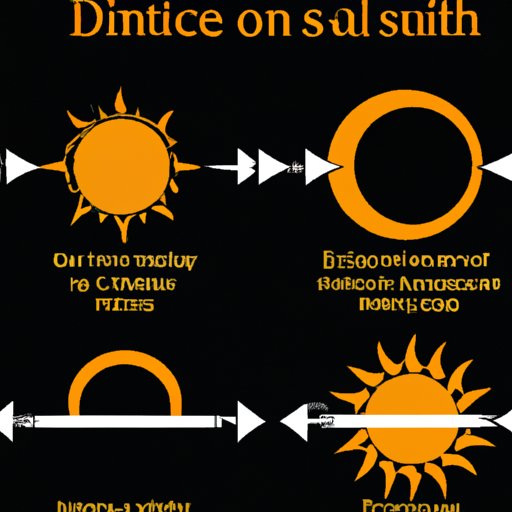Introduction
Have you ever wondered how far the Sun is from the Earth? Our planet’s relationship with the Sun is essential to life on Earth, and this connection is a central topic in astronomy and many other fields. The Sun provides light and energy to our planet and serves as the focal point for the structure of our solar system. Knowing the distance between the Sun and Earth is vital in understanding this relationship. In this article, we will explore this distance, and why it is essential to our lives and the universe.
An Overview of the Distance between the Sun and Earth
The distance between the Sun and Earth is a astronomical unit (AU), which is about 93 million miles or 149.6 million kilometers. An AU is the average distance between the Earth and the Sun. This distance changes over time due to the elliptical shape of the Earth’s orbit around the Sun, causing Earth’s distance from the Sun to vary from about 91 million miles to 94.5 million miles. Understanding the distance between the Sun and Earth is of utmost importance as it determines the amount of sunlight and energy we receive, the temperature and climate on our planet, and the overall structure of our solar system.
Comparing the Distance between the Sun and Earth with Other Planets and Stars
While the distance between the Sun and Earth is crucial, we also need to understand how it compares to other planets and stars. The closest planet to the Sun is Mercury, which is about 36 million miles (58 million kilometers) away; The furthest planet, Neptune is about 2.7 billion miles (4.3 billion kilometers) from the Sun. Many scientists continue to search for other celestial bodies beyond our solar system, such as exoplanets, and have found that they even span light-years away. The nearest star to our solar system, Alpha Centauri, is about 4.37 light-years away, which means that its light takes over 4 years to reach Earth. Understanding the distance between the Sun and other celestial objects can help us comprehend our place in the universe.
The Historical Context of Measuring the Distance between the Sun and Earth
Scientists have been fascinated with determining the distance between the Sun and Earth for centuries. Some of the significant figures in the history of astronomy, such as Aristarchus and Hipparchus, made significant contributions towards measuring this distance by developing methods such as observing the Sun’s position in the sky from different parts of the Earth and tracking the Moon’s movement in the nightsky to measure shadow lengths. In the late 17th century, Jean-Dominique Cassini was the first person to use parallax measurements to determine the distance, laying the groundwork for triangulation. Over the centuries, our understanding of this distance has evolved as new tools and methods have developed.
An Astronomical Perspective on Measuring the Distance between the Sun and Earth
Today, scientists use various methods and instruments to measure the distance between the Sun and Earth. One such method is parallax, or measuring the difference in the object’s position measured from separate points to calculate its distance. Astronomers use radar to determine the distance between planets as lightweight radar-directed probes are sent out to travel, move within, and orbit around the solar system. Another way is to use spacecraft such as the Mars Rover, to calculate the distance between Earth and Mars. Having accurate calculations of the distance can help us accurately predict celestial events, plan space exploration, and track celestial bodies.

The Philosophical Perspective of the Distance between the Sun and Earth
The distance between the Sun and Earth goes beyond just being of interest to astronomers and scientists, as it raises some significant philosophical questions, such as the purpose and meaning of life. Some people see the vastness of space as reaffirming the fundamental insignificance of human existence, while others see it as a way to appreciate the universe’s sheer size and further understand the complexity of it. The philosophical implications of the distance between the Sun and Earth provide people with a sense of wonder and appreciation for the universe.
The Science behind Measuring the Distance between the Sun and Earth
Measuring the distance between the Sun and Earth is a complex process that involves several mathematical and physical calculations. Scientists use parallax, triangulation, and trigonometry in determining the distance between the two. Parallax measures differences in position by capturing images from different angles, triangulation measures distance through angular relationships, and trigonometry uses both to calculate distance through known objects’ angles. The science involved in determining this distance is a testament to the complexity of our solar system and the universe.
An Article for Kids and Beginners
The distance between the Sun and Earth is about 93 million miles, which may sound very far, but it takes only eight minutes for the Sun’s light to reach Earth. To put the distance into perspective, it would take you more than 100 years to travel to the Sun in the fastest car ever made at a speed of 100 miles per hour. During the trip, you would have to stop for gas at every gas station along the way! That’s how far the Sun is from Earth, and why it’s essential to our planet.
Conclusion
The distance between the Sun and Earth is of paramount importance, as it is a fundamental component of our solar system and our lives. Understanding this distance helps us make predictions, plan space exploration, and gain insight into some of the deepest philosophical questions about the universe. From historical methods like observing the night sky to today’s advanced spacecraft technology, our understanding of this distance continues to evolve. By understanding the Sun-Earth relationship and our existence in the universe, we can appreciate the universe’s complexity and guide our exploration of space.
